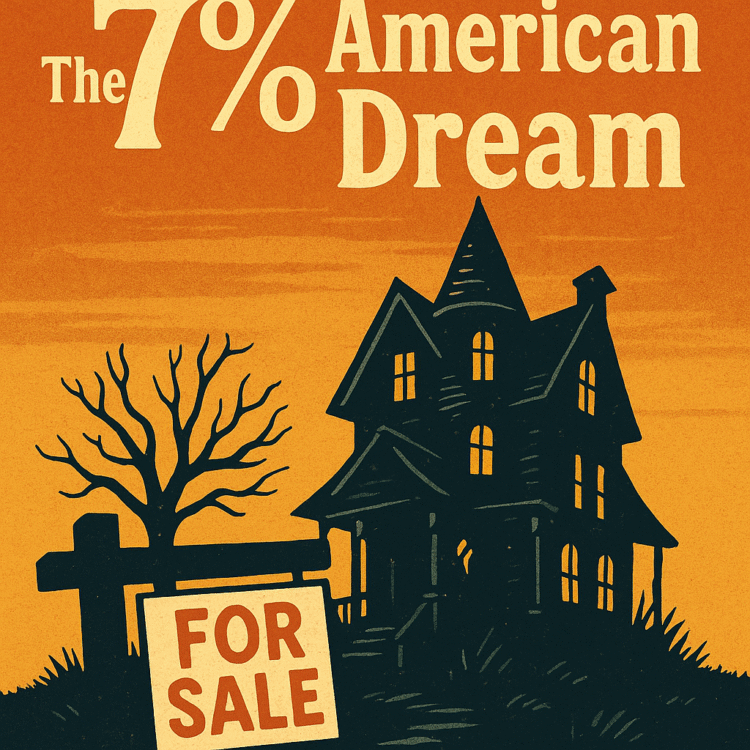
Mortgage rates are now brushing 7%, and the experts—those same people who didn’t see 2008 coming, who told us crypto was the future, and who still insist kale is delicious—are saying the days of historic lows are “probably over.” Translation: welcome to your forever rent.
Seven percent doesn’t sound like much until you remember that it’s seven percent of hundreds of thousands of dollars over thirty years. That’s not a gentle sip from your paycheck—that’s a permanent IV drip into the veins of your bank’s CEO. You don’t just buy a house now. You adopt a lender. You feed them. You clothe their second yacht. You fund their child’s semester abroad in Florence where they “discover” wine.
I remember when my grandparents bought a three-bedroom brick house for $29,000 and thought they were stretching it. I just saw a listing for a 620-square-foot condo in Austin that costs $779,000, has no parking, and smells faintly of vape juice. The realtor called it “full of character.” I call it “a financial suicide note with an HOA.”
At 7%, buying a home isn’t a milestone anymore—it’s an act of performance art. You’re not investing. You’re cosplaying as someone who can afford stability. The whole system now feels like a dystopian HGTV special: Welcome to House Haunting, where the host tours you through dream homes you can’t afford while reminding you, in a sing-song voice, how much worse it will be next year.
And then there’s the chorus of “Well, in the ’80s rates were 12% and people survived!” Yes, and in the ’80s you could work one job at the hardware store and still pay for a house, two kids, and a vacation to Disney. Also in the ’80s, waterbeds were considered sexy. Let’s not pretend all history is worth repeating.
The advice now is to “marry the house, date the rate.” Which sounds cute until you realize you’ve essentially agreed to a financial situationship with a bank, hoping one day they’ll wake up and decide to be less abusive. But the rate isn’t going to “change,” babe. The rate is out at the club, whispering in the ear of someone else’s mortgage application.
If you can’t buy, the alternative is renting—which, in many cities, now costs more than a mortgage. I saw a one-bedroom in San Francisco listed for $4,300 a month, and the landlord described it as “cozy” because your knees hit the sink when you sit on the toilet. Meanwhile, cities are building “micro-apartments” where your bed folds into your desk and your desk folds into your sense of dignity.
And the experts want us to believe this is all perfectly normal. That 7% is “the new standard.” That our expectations of home ownership were childish fantasies, like believing in Santa Claus or bipartisan cooperation.
Here’s the real kicker: we’ve been told for decades that owning a home is the cornerstone of the American Dream. Now it’s starting to look more like the cornerstone of a gated community we’ll never be allowed into. It’s as if the Dream itself has applied for historic preservation status—locked behind a velvet rope, preserved for people who already own three investment properties and a ski lodge.
So what do we do? Some will pivot to “alternative living”—tiny houses, converted vans, co-ops, off-grid cabins in Montana where the Wi-Fi is spotty but the existential dread is strong. Others will double down on the idea that if they just eat out less, skip the oat milk lattes, and get a third side hustle selling artisanal dog sweaters on Etsy, they too will afford that two-bedroom ranch in twenty-nine years.
As for me? I’m adjusting my expectations. I’ll take stability where I can get it, even if it’s a rent-controlled apartment with a “quirky” bathroom window that opens into my neighbor’s kitchen. At least I can still afford oat milk.
Because the truth is, the American Dream isn’t dead—it’s just been subdivided, flipped, and listed at 7% interest. And if you can’t buy it, you can always stream it.